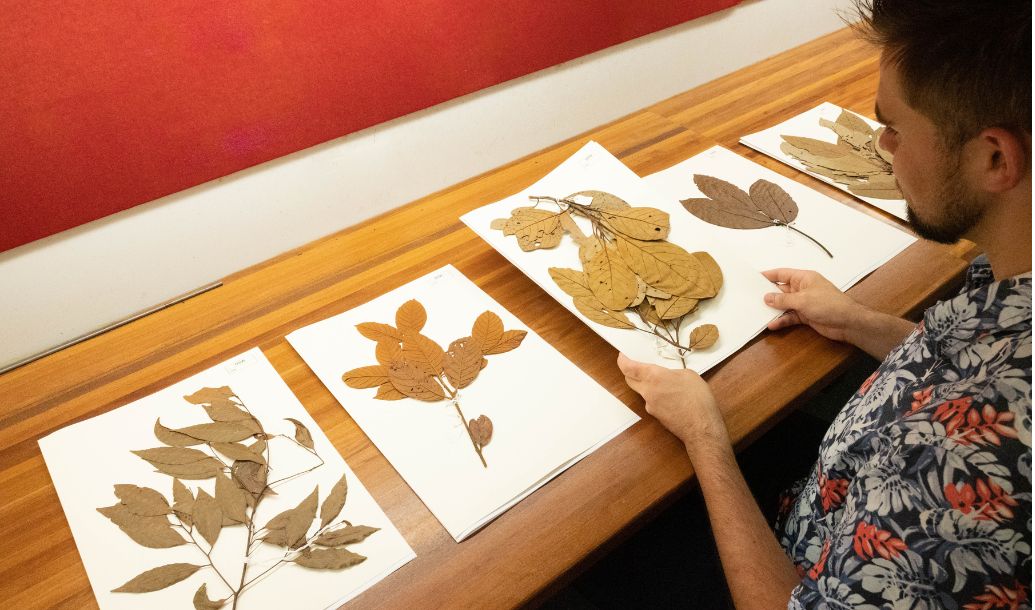After suffering bushfire, flood and covid-related delays, our flagship program Science Saving Rainforests has sprung into action and is quickly making up for lost time.
Most excitingly, the DNA sequencing phase of the program has begun, with a number of species currently being analysed by Diversity Arrays Technology in Canberra. This stage of the project will see the DNA of around 10,000 leaf samples sequenced to identify trees with the optimal genetic diversity to plant in a plantation that will provide stock for future restoration plantings – a living seed bank to produce genetically optimal planting stock of up to 60 species that were confined by land clearing into small, isolated populations. The 60 species include 30 threatened species and 30 key structural species that mainly comprise the closed canopy that characterises lowland subtropical rainforest and contributes to it warm, moist micro-climate.
By analysing the sequenced DNA, our partner the Research Centre for Ecosystem Resilience (ReCER), Royal Botanic Garden Sydney is able to capture genetic, climatic and ecological profiles across the range of each species.

Leaf samples are collected from around Qld and NSW, then freeze-dried and stored at the Royal Botanic Garden Sydney.
This information will then be used by ReCER to undertake genome analyses of each of the 60 species and identify ~20 individual trees or populations that have the optimal genetic diversity for the Big Scrub. From there, cuttings, juveniles or seed of each of the identified specimens/ populations will be propagated and planted in a Macadamia-style plantation, bringing these scientifically-selected individuals back together to reverse the inbreeding depression caused by their isolation.
Furthermore, and most importantly, the optimal genetic diversity identified by genome analyses will incorporate added resilience to climate change and future pests and diseases.

DNA is extracted from the dried leaf samples.
As at early March, we are pleased to report the following work that is underway:
- 7,000 leaf samples collected: by our partner Dr Robert Kooyman, one of Australia’s leading rainforest field ecologists, and his colleagues
- 32 species sampled: in the collections to date – a search is undertaken at collection sites across the population range of each species and a sample taken from 6 individuals of each
- 3,700 DNA extractions: performed by the team at Diverse Arrays Technology in Canberra

DNA sequencing of thousands of leaf samples is underway.
What the DNA sequencing is able to do is quite astonishing. For instance, ReCER can tell us how long populations have been separated, look at environmental and climatic variations and a range of other factors to identify, for each species, the best individuals/ populations to collect seed, cuttings or juveniles from.
We hope to complete the leaf sample collections of the initial 32 species and have a steady flow of DNA sequences by the end of March. ReCER will then conduct genome analyses of each species when all of its leaf samples have been DNA-sequenced and identify the best parent trees from which to collect propagules from to plant at our plantation site.
Three phases will follow that step:
1. The collection of propagules (cuttings, juveniles or seed) from the up to 20 target individuals, or populations of each species
2. The propagation and planting of the genetically optimal stock in a Macadamia-style plantation in Wollongbar and potentially at other sites.
3. After up to ten years, these parent trees will cross-pollinate, fruit and produce seed for propagation into genetically optimal planting stock to be distributed for restoration plantings including expansion of remnants.
In the future, we hope this methodology will also be applied to enhance the longevity and sustainability of major reforestation projects and carbon sequestration plantings.
Science Saving Rainforests is a long-term program and a ground-breaking approach with the potential for worldwide application where similar fragmentation and degradation of ecosystems has resulted in small isolated plant populations lacking genetic diversity – a weakness which threatens these remaining isolated ecological communities, like the Big Scrub, with extinction.
We want to mention and thank the key supporters of Science Saving Rainforests: The Saving our Species Unit in the NSW Dept of Planning and the Environment, the Big Scrub Foundation, the NSW Environmental Trust, NSW Department of Primary Industries, Stone & Wood Brewing Co, Brookfarm, Cape Byron Distillery and other donors who wish to remain anonymous.


